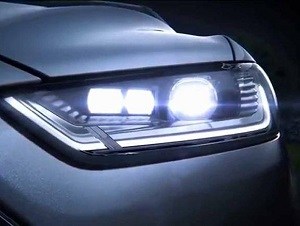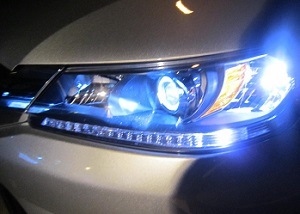by Joshua Thomas
When it comes to car headlights, LED and HID are the two names that stand out and continue to gain popularity over the now fast aging halogen technology.
If you are like most car owners and drivers, the words LED and HID might seem confusing, since they both describe modern headlights, which are both very similar to one another.
These two headlight technologies might seem similar, but they are very different. They also each have their advantages and disadvantages.
The following side by side comparison will take a closer look at these similarities and differences.
Contents


LED is an acronym for Light Emitting Diode. It is a technology which produces light by exciting a semiconductor and forcing it to release light particles.
This technology has been around for many decades, but it was restricted to green, blue, and mostly red-colored LEDs. It was in the 1990s that white LEDs got developed and their use began to spread.
LEDs are popular because of their energy efficiency and flexibility of design. They are also cool to the touch and brighter than halogen bulbs.
Although HID or Xenon lamps are brighter than LED bulbs, both produce bright white beams that are typical of modern cars.
For an aftermarket LED installation, you can either buy a drop-in LED replacement kit or an entire headlight kit, which is usually more expensive. These LED replacement kits are more popular.
The functioning principle of the light emitting diode is that of electroluminescence. This happens when photons, which are also known as light particles escape as a result of electron movement through a semiconductor.
A LED is a kind of diode, which is 2 semiconductors that are attached together. One side must always be positively charged, while the other must always be negatively charged.
When an electric charge gets applied to this semiconductor junction on both poles, electrons tend to move in one direction only. This leads to the diodes functioning as controllers of electricity flow direction.
With LEDs though, electrons from the current recombine with positively charged atoms through the p-n junction (Positive-Negative junction). But, before recombining, these electrons release their photons, which are the light particles that create light.
This release of light particles is known as electroluminescence and the coating of the p-n junction with the right filter materials will produce any desired color of light.

HID stands for High-Intensity Discharge lamp and is a technology that produces light by passing current between 2 electrodes that are sealed inside a bulb with an ionized gas.
There are different variations of HID bulbs, including those which use Mercury, Sodium, and Metal Halide, but when it comes to car headlights, Xenon is the most popular choice. HID bulbs are also named for the gas they contain.
Xenon HID headlights produce the brightest and whitest light beams that get used in cars today and they have slowly and almost surely, replaced halogen lights in most cars.
They are more than twice brighter than halogen lights but only slightly brighter than LEDs. HID bulbs are also more energy-efficient than halogen bulbs but they are less energy-efficient than LED lights.
Although LEDs have a longer lifespan than HIDs, they both cost roughly the same, with LED headlights being costlier upfront but HID headlights requiring more maintenance in the long run.
High-intensity discharge bulbs work in a similar fashion to neon lights. Electric current passes through a gas-filled tube with electrodes at both ends of it, and the high voltage of this current ionizes the gas and creates a glow.
There is no filament here and the heating up of the Xenon gas needs lots of energy. It is necessary to keep exciting this Xenon gas with high voltages over 20 kV until the tube reaches its working temperature.
Once it reaches this temperature, the metallic salts also contained inside the bulb melt and vaporize as well. This is when resistance reduces, more current flows between the 2 electrodes, and the HID bulb reaches its maximum brightness.
Pros
Cons
HID and LED bulbs each have their different advantages and disadvantages. So, for you to make the best buying decision, you'll have to consider their features. Following is a list of these features.
| LED | HID | |
|---|---|---|
| Energy efficiency | Most efficient | Very efficient |
| Warm up | Instantaneous | Takes up to 30 seconds |
| Dimmable | Possible | No |
| Brightness | Above 2,000 Lumens | Around 3,000 Lumens |
| Cost | Average | Average |
| Lifespan | Over 5,000 hours | 2,000 - 5,000 hours |
| Color temperature | 4,000-6,000K | 4,000-6,000K |
| Durability | Shockproof & vibration resistant | Fragile |
LED and HID headlights are both based on 2 different but impressive technologies. They are both equally impressive and modern technologies, and you'll be well served to choose any of them.
Depending on your needs though, HID lamps will serve you better if you need the most illumination possible, especially if you are speeding.
If however, you just need a great lighting solution, which is affordable, stylish, and has a future, then you'll be best served with an LED headlight.
 |
 |
 |
 |

About Joshua Thomas
Joshua Thomas just simply loves cars and willing to work on them whenever there's chance... sometimes for free.
He started CarCareTotal back in 2017 from the advices of total strangers who witnessed his amazing skills in car repairs here and there.
His goal with this creation is to help car owners better learn how to maintain and repair their cars; as such, the site would cover alot of areas: troubleshooting, product recommendations, tips & tricks.
Joshua received Bachelor of Science in Mechanical Engineering at San Diego State University.
Just Car Care